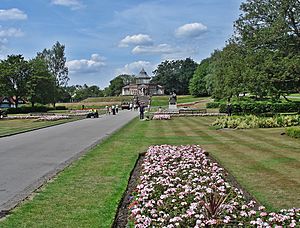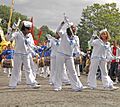Mesnes Park, Wigan facts for kids
Quick facts for kids Mesnes Park |
|
|---|---|

Mesnes Park, looking towards the Pavilion
|
|
| Lua error in Module:Location_map at line 420: attempt to index field 'wikibase' (a nil value). | |
| Type | Public park |
| Location | Wigan, Greater Manchester, England |
| OS grid | SD579064 |
| Operated by | Wigan Metropolitan Borough Council |
| Status | Open all year |
Mesnes Park is a beautiful public park in Wigan, Greater Manchester, UK. It first opened in 1878, making it a historic Victorian park.
This park is about 12 hectares (which is like 30 acres) in size. It sits northwest of Wigan town centre. You can find its main entrance where Bridgeman Terrace and Mesnes Park Terrace meet. The park has lovely flower beds, green lawns, a pond, and fun playgrounds for kids. There's also mini golf, sports areas, and a cozy café.
Recently, the park got a big makeover. Millions of pounds were spent to restore it. This was possible thanks to a grant from the Heritage Lottery Fund.
Contents
What makes Mesnes Park special?
Mesnes Park is a very important historical site. It is officially listed as a Grade II park. This means it has special historical or architectural interest. Inside the park, you will find seven original features that are also Grade II listed.
The main entrance and lodge
The park's main entrance has impressive stone pillars. It also has strong cast iron gates. These gates show the Wigan town shield and the year 1878.
Right next to the entrance is the lodge building. This old building has been updated. It is now used for meetings and even weddings.
Statue of Sir Francis Sharpe Powell
As you walk into the park, you will see a bronze statue on your right. This statue honors Sir Francis Sharpe Powell. He was a local Member of Parliament (MP) and a kind person who helped the community. People say that touching his bronze foot brings good luck!
The Pavilion and memorials
At the end of the main path, you will find two sets of stone steps. These steps lead up to the park's main building, the Pavilion. At the top of the steps, there is a memorial. It remembers the soldiers who fought in the Boer War.
The Pavilion is the most important building in the park. It has a café where you can grab a snack. It also has two floors of seating. The building is shaped like an octagon. It is made of cast iron and covered with brick and terracotta tiles.
Another set of steps, similar to the first, leads down from the other side of the Pavilion.
The bandstand
The park also has a 10-sided bandstand. It is made of cast iron columns. Its roof is made of wood covered with metal. This bandstand has recently been updated with electricity.
How Mesnes Park began
The land where Mesnes Park now stands was once known as the Mesnes. This name came from "demesnes," which means land owned by the lord of the manor. In Wigan, the Rector of Wigan was the Lord of the Manor. So, this land was part of the Wigan Rectory Estate. By 1847, there were even two coal mines working within the park's current boundaries.
In 1871, the Wigan Corporation bought about 6.5 hectares (16 acres) of the Mesnes land. They planned to build a Grammar School and a public park there. Nathaniel Eckersley, who was the Mayor of Wigan at the time, helped arrange this purchase. They also leased another 5.5 hectares (13.5 acres) of land. This included the site of Turner's Colliery, a coal mine that kept operating until 1880.
In 1877, a competition was held to design the new public park. John McClean from Castle Donington won the competition. He was then hired to oversee all the work.
Nathaniel Eckersley, who was then the High Sheriff of Lancashire, officially opened Mesnes Park in August 1878.
Images for kids











